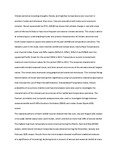| dc.description.abstract | Climate extremes including droughts, floods, and high/low temperatures are recurrent in
southern Sudan and whenever they occur, they are associated with many socio-economic
miseries. Recent assessment by IPCC, (2013) has shown that climate change is real with many
parts of the world likely to face more frequent and severer climate extremes. This study is aimed
at enhancing our understanding of past and present characteristics of climate extremes over
South Sudan based on space-time patterns of the past rainfall and temperature extremes. The
datasets used in this study were monthly rainfall and temperature, Sea Surface Temperatures
over tropical Indian Ocean and Niño regions (Niño1+2, Niño3, Niño3.4 and Niño4) over the
equatorial Pacific Ocean for the period 1961 to 2013. Temperature records included both
maximum and minimum values for the period 1954 to 2013. The temporal characteristics
examined included seasonal trends, and inter-annual recurrences of the extreme lowest/ largest
values. The trends were examined using graphical and statistical techniques. This included fitting
determination of trends and testing their significance using non-parametric statistical approaches
that included the use of Mann Kendall Statistics. Standardized Precipitation Index, Simple
probability of occurrence statistics and Spectral analysis were also used to investigate the
characteristics of the interannual recurrences of the rainfall and temperature extremes. The
Pearson correlation and composite analyses were also used to investigate linkage between
seasonal rainfall and El Niño Southern Oscillation (ENSO) and Indian Ocean Dipole (IOD)
events.
The seasonal patterns of both rainfall records showed that the June, July and August (JJA) season
is the peak rainfall season over south Sudan, which contributes more than 50% of annual rainfall.
The highest maximum temperatures were observed during the March, April and May (MAM)
season, while lowest minimum temperature was observed during the December, January and
February (DJF) season. Results from the trend analysis showed insufficient statistical evidence
of a significance of increasing/ declining tends in amount of annual and seasonal rainfall at many
locations, while both maximum and minimum temperature indicated statistical significant
evidence of increasing trends for all locations considered in study at 0.05 level of significant.
The inter-annual patterns of rainfall indicated recurrent patterns of floods and droughts over some locations used in the study. The Spectral analysis of rainfall and temperature showed
significant recurrent modes of one to two spectral peaks within period of 3 to 8 years, which can
be attributed to some common large scale forcing mechanisms within atmosphere and ocean
components such as Quasi-Biennial Oscillation (QBO) in the lower stratospheric zonal winds, El
Niño and La Niña events.
The observed spatial patterns of rainfall and temperature for current period1984-2013 relative to
1954-1983 and 1961-1990 indicated that, climate change and variability signals are real in south
Sudan and results showed insignificant decline in amount of rainfall and significant increasing of
temperature over most locations in south Sudan. The variations in spatial patterns confirmed by
probability distributions of Long Term Mean (LTM) of rainfall and temperature of two periods
(1954-1983) and present (1984-2013), which showed increase in both means and variance and
changes in asymmetry toward the hotter and heat waves for temperature and high probability of
occurrence of drought, floods for rainfall.
The correlation coefficients and regression model between seasonal rainfall and IOD and ENSO
events at zero and one Lag season indicated weak teleconnection and IOD and ENSO
contributing less than 20% of variability in rainfall. The composite analysis established facts that
most of locations observed normal rainfall and some of the extreme rainfall conditions that
occurred over South Sudan were found not coincide with positive and negative IOD and weak,
moderate and strong ENSO phases. These results can help policymakers to make more informed
knowledge based decisions for mainstreaming of climate related risks into sustainable
development policies, Disaster Risk Reduction (DRR) and Climate Change Adaptation (CCA)
strategies | en_US |


